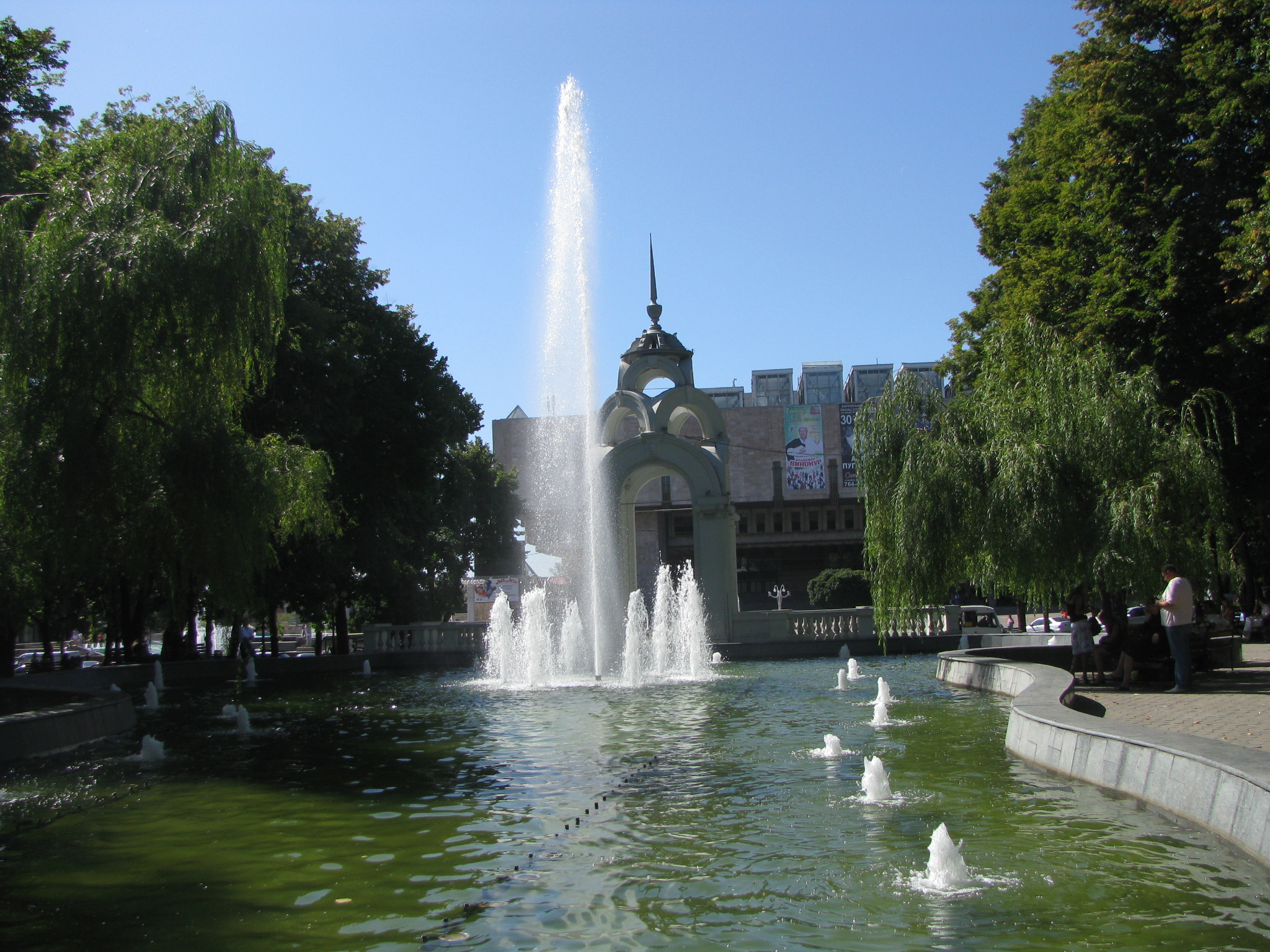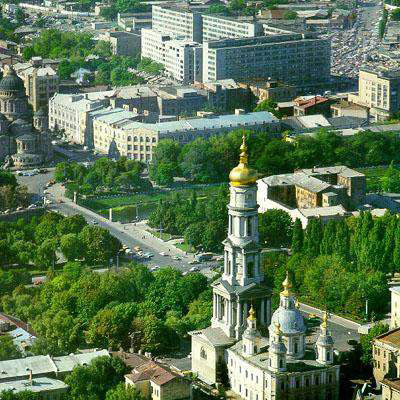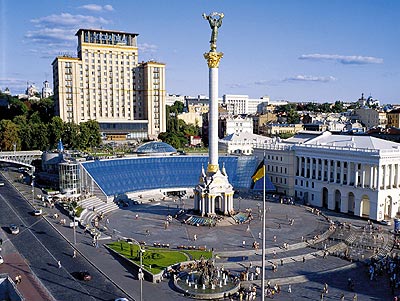
Complete the sentences using the words and phrases given bellow in brackets:
The Kharkov college of (залізничного транспорту) is a higher educational establishment of the I-II level of accreditation which ( спеціалізується на підготовці спеціалістів) of an average link for the enterprises of a railway transportation.
At the Kharkov college of Railway transport is an assembly hall on 200 places with a film projector for demonstration of(навчальних фільмів), technical library with a (читальна зала)which fund makes over 13000 names, or 48600 copies.
( за час існування)the college has prepared about 19000 specialists.
Text 6. Kharkiv
Kharkiv is quite an old city. It was founded about 350 years ago.
The city is situated on the plateau surrounded by the Kharkiv and the Lopan rivers. According to the popular legend the city is named after Cossack Kharko. Kharkiv is the historical capital of Slobidska Ukraine.
With the foundation of Kharkiv University in 1805 the city became an important educational and cultural centre of Ukraine and the Russian Empire as a whole. Such cultural figures as Kvitka- Osnovianenko,Hulack- Artemovsky, Kostomarov, Repin lived and worked in Kharkiv.
Kharkiv was the capital of Ukraine since 1919 till 1934. Today Kharkiv is the second largest city in the country. About 2 million people live here.
Kharkiv is one of the largest industrial centres in Ukraine. Its numerous enterprises produce planes, tractors, electronic, mining and medical equipment, TV-sets, refrigerators, paints and cosmetics, clothing and textiles. Furniture and printing industries are well developed in Kharkiv.
Kharkiv is one of the major cultural and scientific centres of Ukraine. There are many schools, higher educational establishments, research institutes in Kharkiv. There is the Scientific Library, the Historical and Natural Science Museums and the Museum of Fine Arts in Kharkiv. The city supports a circus and six professional theatres.
Kharkiv is very beautiful, especially in spring. There are over 2500 streets and 26 squares in the city. The largest parks are Gorky Park, Shevchenko Garden with the Zoo, Artem Park, the Forest Park and some others. The city is ornamented with a large number of monuments. The most prominent of them is the one to T. Shevchenko built in 1935.
Kharkov
is famous for its architectural monuments, parks and green areas.
Shevchenko Park which is one of the most beautiful parks in the city
centre. In this park you are able to visit the zoo; the water
cascade-one of the famous spots in Shevchenko Park, it opens the
beautiful view on the city; Mirror Stream, a small park with the
beautiful fountain and belvedere, is one of the most romantic places
in Kharkov.
There`re many cafes, restaurants, new green “islands” and playing
grounds for children.
Gorki Park is the biggest park near the centre, its total square consists of 130 hectares. It`s famous for its vast green land and park amusements. One of the main attractions there is the cable way which will take you from the city centre to Alekseevka Region!
Kharkov Subway is famous for its beauty and simplicity.There are three lines in modern Kharkov Subway – Alekseevskaya (7 stations, total length – 8 km), Saltovskaya (8 stations , total length – 10,4 km), Kholodnogorsko-Zavodskaya (13 stations – total length – 17,3km). Each underground station has its own unique design created by famous architects and will certainly be of interest to tourists.
T here
are more than 40 of higher educational establishments in Kharkov:
state and private universities and institutes and academies, not
taking into account colleges and vocational schools. Many foreign
students come to Kharkov to learn Russian as one of the foreign
languages.
here
are more than 40 of higher educational establishments in Kharkov:
state and private universities and institutes and academies, not
taking into account colleges and vocational schools. Many foreign
students come to Kharkov to learn Russian as one of the foreign
languages.
If you are a theatre lover, Kharkov is a great place for you. There are more than 15 theatres, one of the most famous is Opera and Ballet Theatre where not only local, but world stars perform.
There is wide range of places to eat out where you can taste Ukrainian, Russian, Georgian, Armenian, Italian, French, Japanese, Indian and Chinese cuisine in Kharkov. The city is also rich with its night life and entertainment centers where you can visit a cinema, play billiards or bowling.
Kharkov was chosen as one of the cities for EURO-2012. State authorities have started building of the Eastern Stands in the “Metallist” stadium, by the end of 2009 the stadium reconstruction will be completed and it will be presented for UEFA experts’ approval. For the championship not less than five 5* hotels, 13 – 4* and 3* hotels will be built. There are about 161 hostels which will allow to accommodate football fans and foreign guests during their visit to Kharkov.
Text 7. Kyiv – the Capital of Ukraine
Kiev (or Kyiv) is the capital and the largest city of Ukraine, located in the north central part of the country on the Dnieper River. The name Kiev is derived from the name of Kiy, one of four legendary founders of the city.
By the ancient legend Kiev was founded by three brothers Kiy, Schek, Khoriv and their sister Lybid. They were surprised by the beauty of Dnieper’s hills, stopped to settle here and called the town in honour of the eldest brother-Kiev. A monument to the founders was erected at the Dnieper embankment in our days. The town’s place was chosen succesfully, the high Dnieper’s slopes were perfect protection against the raids of nomad tribes.
Kiev stretches for the space of more than 20 km along the picturesque banks of the biggest Ukrainian river — Dnieper. Its square consists 827 sq.km. The population of Kiev is about 3 millions people.
Kiev is one of the oldest Slavic centres, “Mother of Russian touns” so it was called in olden times, its age is more than 1500 years. The first settlements on the territory of modern Kiev appeared from 15000 till 20000 year ago.
During the time of Vladimir the Great (980-1015) government our city begins to develop especially rapidly. In order to consolidate Kiev Russ and to increase its international influence the prince Vladimir baptised the Russ in 988. Christianity and became that impulse for further development of written language and culture.
Today Kiev is an important industrial, scientific, educational and cultural centre of Eastern Europe. It is home to many high-tech industries, higher education institutions and world-famous historical landmarks. The city has an extensive infrastructure and highly developed system of public transport, including the Kiev Metro.

The capital of Ukraine has got great cultural potential. There are more that 30 museums, about 200 unique architectural monuments, 33 theatres, enormouse quantity of constant active art exhibitions. Kiev is one of the greenest cities of the world, it has more that 60 parks. In spring and summer the city resembles one huge park.
There are many historical places in Kiev. For example, St Sophia Cathedral, which was built in the 11th century, Kievo-Pecherskaya Lavra that was founded in the 11th century, St Michael’s Golden-Domed Monastery, which was ruined and recently completely restored, St. Andrew’s chirch in baroque style?
The monument to Taras Shevchenko, the great Ukrainian poet, is in front of the University, named after him. The monument to Bohdan Khmelnitsky, famous hetman of Ukraine, stands in the square opposite to St Sophia Cathedral.
Kiev is the centre of cultural life of Ukraine. Fans of theatre, cinema, music, painting and other arts can find there many interesting for themselves. There are lots of museums in Kiev: the Museum of Ukrainian Arts, the Historic Museum, the Taras Shevchenko Museum, the Lesya Ukrainka Museum, the museum of M. Bulgakov and others.
Text 8. Computers
Computer is an electronic device that can receive a set of instructions called program and then carry out them. The modern world of high technology could not be possible without computers. Different types and sizes of computers find uses throughout our society. They are used for the storage and handling of data, secret governmental files, information about banking transactions and so on.
Computers have opened up a new era in manufacturing and they have enhanced modern communication systems. They are essential tools in almost every field of research, from constructing models of the universe to producing tomorrow's weather reports. Using of different databases and computer networks make available a great variety of information sources.
There are two main types of computers, analog and digital, although the term computer is often used to mean only the digital type, because this type of computer is widely used today. That is why I am going to tell you about digital computers.
Everything that a digital computer does is based on one operation: the ability to determine: on or off, high voltage or low voltage or — in the case of numbers — 0 or 1 or do-called binary code. The speed at which the computer performs this simple act is called computer speed. Computer speeds are measured in Hertz or cycles per second. A computer with a «clock speed» of 2000 MHz is a fairly representative microcomputer today. It is capable of executing 2000 million discrete operations per second. Nowadays microcomputers can perform from 800 to over 3000 million operations per second and supercomputers used in research and defense applications attain speeds of many billions of cycles per second.
Digital computer speed and calculating power are further enhanced by the amount of data handled during each cycle. Except two main types of computers, analog and digital there are eight generations of digital computers or processing units. The first generation was represented by processing unit Intel 8086.
The second generation central processing unit was represented by processing unit Intel 80286, used in IBM PC AT 286. The third generation is Intel 80386, used in IBM PC AT 386. The microprocessors of the fourth generation were used in computers IBM PC AT 486. There are also central processing units of the fifth generation, used in Intel Pentium 60 and Intel Pentium 66, central processing units of the sixth generation, used in computers Intel Pentium 75, 90,100 and 133. Few years ago appeared central processing units of seventh and eighth generations. They are much more powerful and can perform from 2000 to over 3000 million operations per second.
Questions:
1. What is computer? 2. What is the main purpose of all computers? 3. Where are computers used? 4. What is the index of computer speed? 5. What speeds do modern computers have? 6. How many generations of digital computer are there? 7. What is the first generation processing unit?
